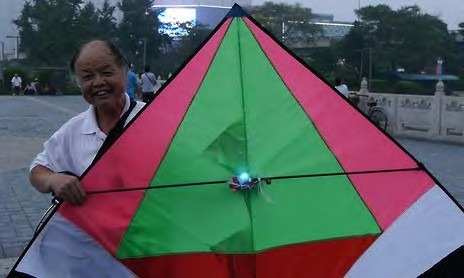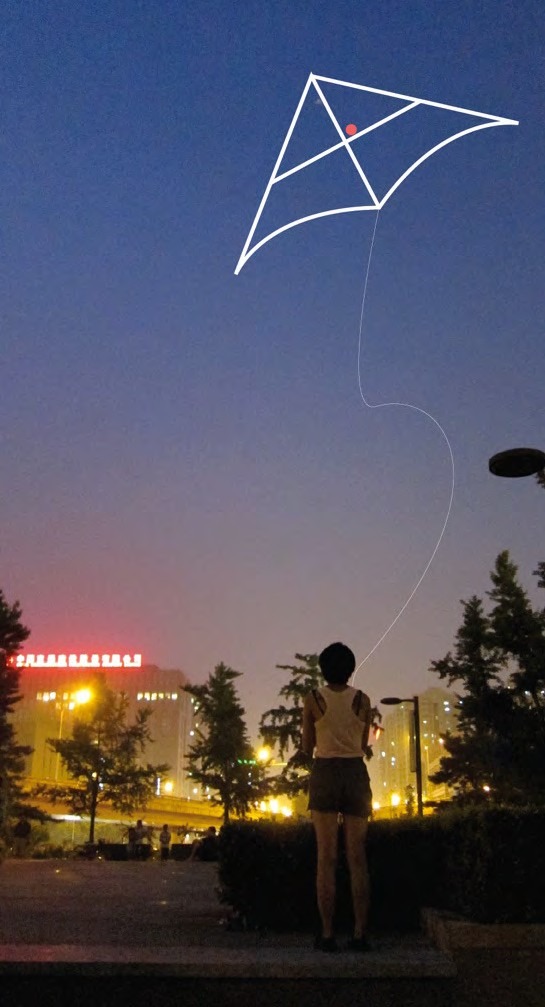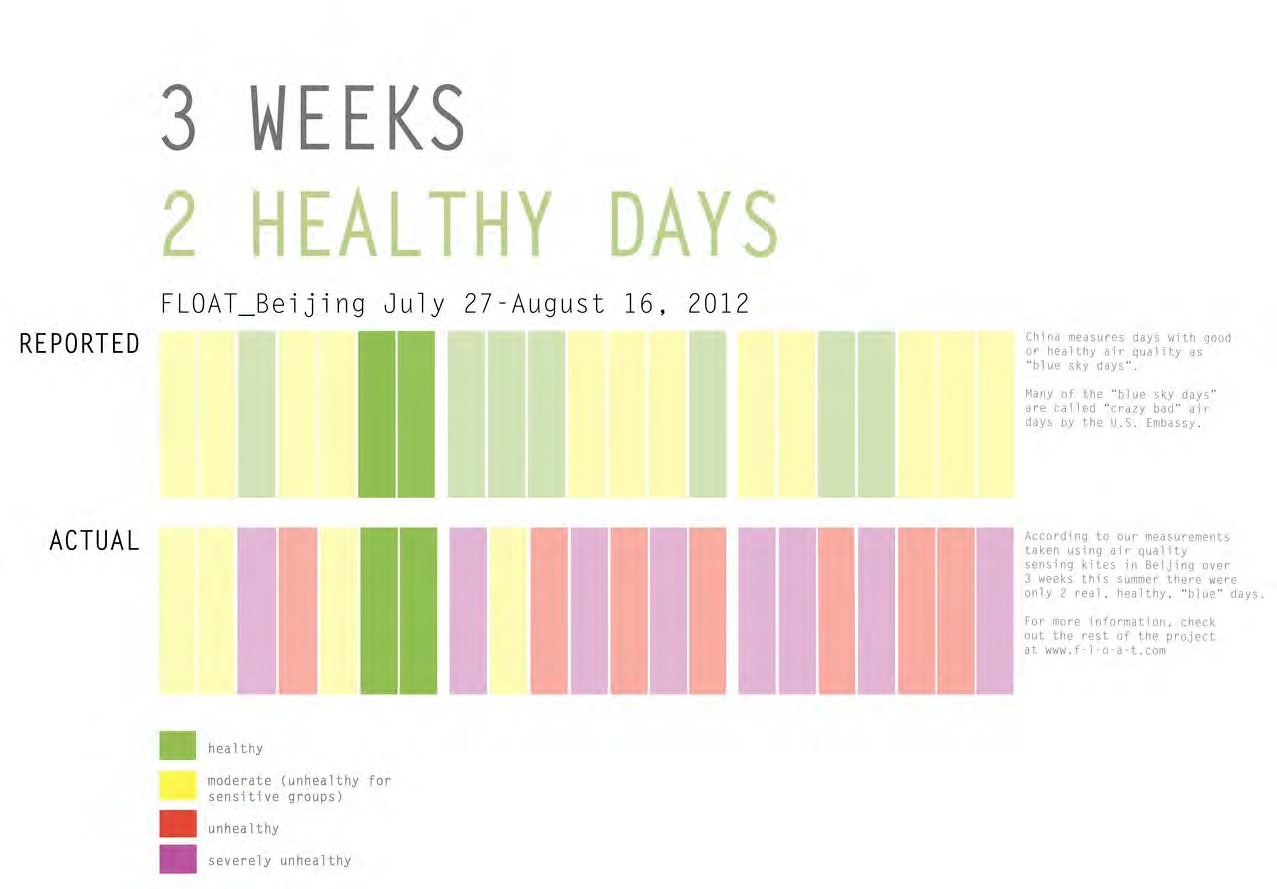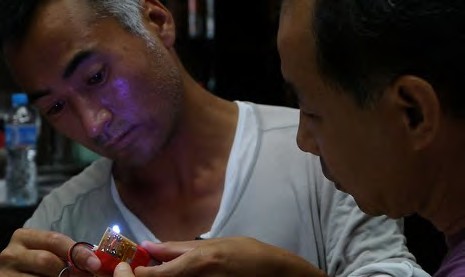Deren Guler
Introduction by Ali Fujino
Throughout time, there has been, what I refer to, as “the force of great ideas…” They can be big or small in nature, but to qualify, they must evolve from the unique vision of an individual who has the ability to put them into action. FLOAT Beijing is one of these great ideas, a participatory design, mapping and open source data visualization project using air quality sensing kites.
I came across this project in one of my weekly passes reviewing stories of kites on the internet.
Text from the Graduate School of Design, Harvard University
Xiaowei Wang (MLA ’13, communications/space design, a master’s candidate in landscape architecture at the Harvard School of Graduate Design) has created a public art event that is also a pollution monitoring project for notoriously smog-ridden Beijing. Wang and her collaborator, Deren Guler, a master’s candidate in tangible interaction design, the Computational Design Laboratory at Carnegie Mellon University, took advantage of the tradition and beauty of kite flying in China to enlist kite enthusiasts in Beijing in mapping air quality measures. Their FLOAT Beijing project also created a constellation of twinkling indicator lights in the city’s night sky.
Part of the project was a series of community workshops to teach local residents how to assemble tiny air quality sensors to attach to the kites. There were group kite flights after the workshops with the sensor modules attached. The modules logged data and had visible LED lights which indicated the air quality levels: pink for poor, green for healthy.
The following interview was conducted with Xiaowei Wang and Sibel Deren Guler.
What is FLOAT Beijing?
FLOAT Beijing is an interactive, community driven art project that uses kitemaking and kite flying to activate dialogue, map and record air quality in Beijing, China. FLOAT Beijing uses local knowledge sharing, public kite flying and creativity to address an urgent ecological, environmental and social urban issue.
Why kites and why air quality?
Urban air quality is a serious issue that affects rapidly industrializing cities globally, and within Beijing as the capital of China, it is an issue kept quiet by the government under fear of criticism and protest from the public. At the same time, there is ample opportunity to use cheap, easily accessible microcontroller technology for grassroots air quality mapping. We see the pairing of microcontroller technology and the traditional art of kite flying as an immense opportunity to give local residents the ability to understand urban air quality.
Our project has two components: a workshop and a group kite flight that uses a special module developed to detect carbon monoxide, volatile organic compounds (VOC’s) and particulate matter. The modules are attached to homemade kites and flown into the air. Detection levels are displayed through LED lights that change in color, creating a constellation of air quality indicating lights in the night sky.
Through a series of workshops, FLOAT Beijing empowers and enables local residents to take air quality monitoring into their own hands, as well as establish new relationships and networks within the community through the act of group kitemaking and flying.

f-l-o-a-t.com. The delta kite used to lift the sensors.

f-l-o-a-t.com. Flying an air-quality monitoring kite.

f-l-o-a-t.com. A computer-generated collage of a kite in flight in the Beijing night sky.
How does it work?
A series of three workshops and group kite flights will be held in Beijing, with outreach to Beijing neighborhood groups and organizations. Together, the community will be able to design and make kites in which the sensing modules are attached and learn more about air quality monitoring and the technology behind it. After the workshops, a group night-time kite flight will take place. Due to light and air pollution, it is extremely difficult to see stars in the Beijing night sky. These kites will appear not only as indicators of urban air pollution, but also a strong visual and sensory experience. As our project is public art, it also brings together people from all walks of life — from old kite masters in Beijing, to young environmentalists, to participate and make the final public art piece together.
How did you and Xiaowei Wang come up with the idea for FLOAT Beijing? What inspired you to hold this activity? Why name the project “FLOAT Beijing”?
There’s currently a large DIY (do it yourself) air quality monitoring movement — with organizations such as the Public Laboratory or the folks who made Air Quality Egg. What really interested us was taking the issue of air quality and tying it in with a traditional craft, as well as adding a poetic aspect to it. We’ve both loved kites since we were kids, and it made sense to use them as a vehicle for air quality monitoring. The project is called FLOAT Beijing because it plays off of how the kites float in the air, but pollution also floats in the air.
Why did you choose Beijing? Why choose to fly kites?
Xiaowei lived in Beijing, and always talked about how the spring dust storms would come in and change the whole sky of Beijing into an orange gray color. It made sense to do this project in Beijing, as we wanted to reach out to local residents and help them learn how to monitor air quality, in addition to the air quality stations that China already has. Kites have a long tradition and his- tory in Chinese culture, so flying kites is not only a way to test air quality, but also a way to engage a population of people in Beijing who might not normally be concerned about environmental pollution. Also, flying kites is fun!
Would you mind explaining to us how to make such a kite? And how to detect the various pollutants in the air with the kites?
The kites are equipped with small modules that contain a sensor, batteries, lights and small microcontroller chips. The data from the sensor’s output is proportional to the concentration of a certain gas in the air (we are measuring CO, Methane, Propane, and VOCs). A few kites have data logging SD cards on them so we can read the data from the card when it comes back down from a flight.
I hear that FLOAT Beijing will continue for three weeks. Will there be any difference in FLOAT Beijing from week to week?
We received a lot of very encouraging and helpful feedback from the first workshop and are hoping for even more next time. The first workshop was an introductory workshop to teach citizens how to assemble the modules and the basic idea. We did not have everything ready as I just arrived from the US the day before! The feedback from the participants and initial test flight was very fun and gave us a lot of tips for next time. In the next workshop we will introduce the data logging modules and a few new sensors.
What is the goal of FLOAT Beijing? Will you come out with something such as air quality reports? What are you going to do with the report or anything learned during The activity?
Our goal for FLOAT Beijing is actually quite humble; we are doing this project so that Beijing residents can start to monitor air quality for themselves. We are not planning on coming out with an air quality report, as there are plenty of NGOs who do work like that; instead, we’re smaller scale and utilize citizen science as a way of spreading environmental awareness.
Would you mind introducing us to the team responsible for FLOAT Beijing? How do you know each other? What have you done to prepare for FLOAT Beijing?
Xiaowei and I have been friends since high school and she met Josh Frank when she lived in Beijing in 2009. We’ve always wanted to collaborate on a project together and FLOAT Beijing seemed like the perfect balance of our skills and goals. Xiaowei is a master’s candidate in Landscape Architecture at Harvard and I am a master’s student in Tangible Interaction Design at Carnegie Mellon University. Josh has a master’s in documentary filmmaking and has produced films for The New York Times. He will be creating a film about the project.
Have you been involved in any projects like FLOAT Beijing before?
We both share a passion for sustainable design. Xiaowei is very much interested in mapping (weather, data, census), and how it can be used to imagine new kinds of urbanism and more sustainable cities. I am interested in DIY “low-tech” solutions to computing. The modules used on the kites are very simple to assemble, making them accessible to a large and diverse audience.
What is your expectation about the following activities of FLOAT Beijing? are you going to do more things to expand the impact of the project?
We hope that more people will attend the workshop next time. We are also excited to try different types of LED lights that were recommended to us by the kite experts. We are also planning on designing a more permanent installation, hopefully at XP, that will visualize the data once the workshops are over.

On your fundraising page, you also regarded FLOAT Beijing as a public art project. Why did you position FLOAT Beijing in that way? How does FLOAT Beijing show the spirit of public art?
We believe that FLOAT Beijing is a public art project as it engages and interacts with people directly. The workshops require local residents to come and work together, and the kite flying is both a night time spectacle for other residents, but is also choreographed by the workshop participants and kitefliers. We feel that the spirit of public art resides in the ability for something visual to inspire new dialogue and relationships between local residents, and that is what FLOAT Beijing seeks to do.
After this project, do you have any plans for other activities like FLOAT Beijing? Does the project relate to your personal career plans?
We’re going to see where the project goes, and will most likely hold workshops and kite flights in other cities as well. Xiaowei is interested in seeing the different levels of air pollution in the city as a function of urban design decisions, as sustainable urban design is one of her main interests. I am interested in exploring different venues for spreading knowledge about environmental and educational issues.

f-l-o-a-t.com. Assembling an LED sensor for one of the kites.
How did you organize FLOAT Beijing? How did you get the funding besides Kickstarter?
We received a grant from the Black Rock Arts Foundation in March which gave us the initial funding for plane tickets and a small materials budget. We also received a small grant from the Awesome Foundation Boston Chapter and the Asia Society for Josh’s documentary about the project. Once the project began to grow we decided to expand to multiple workshops and started our Kickstarter campaign to help cover additional costs. We are so grateful to have received so much support and interest!
To learn more about FLOAT Beijing:
http://www.good.is/posts/glowing-pollution-sensor-equipped-kites-replace-beijing-s-stars
Purchase a FLOAT Beijing Kite: http://f-l-o-a-t.com/post/33366791391/want-to-buy-a-beautiful-kite

